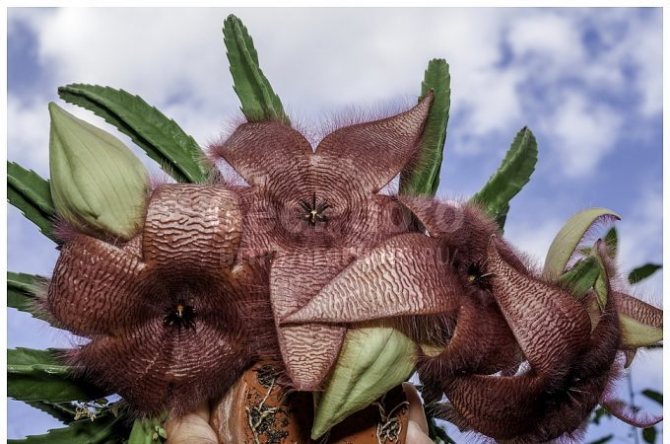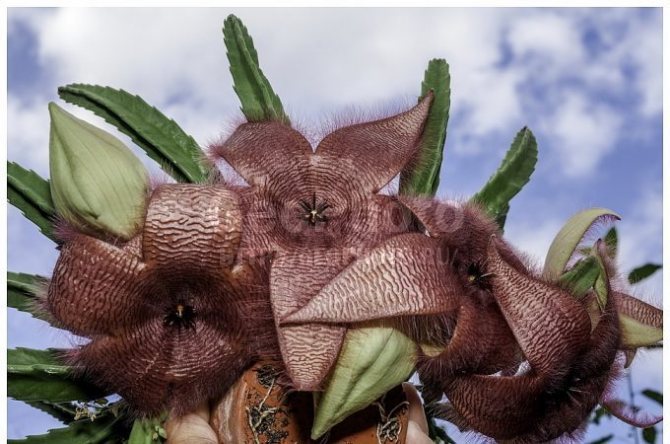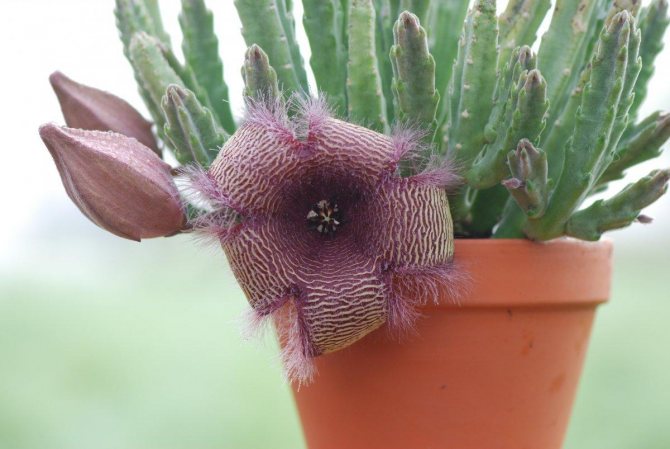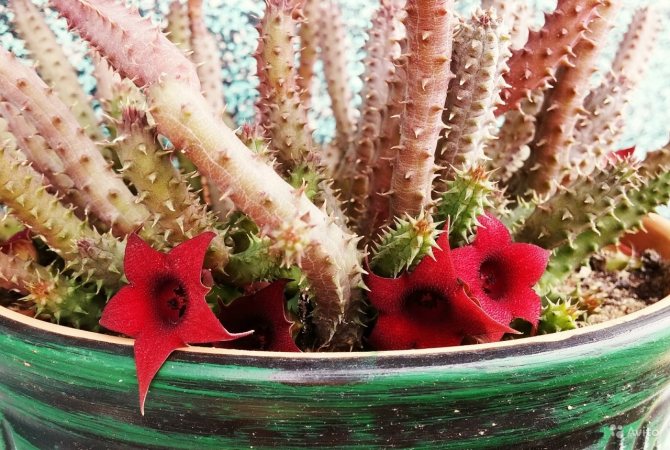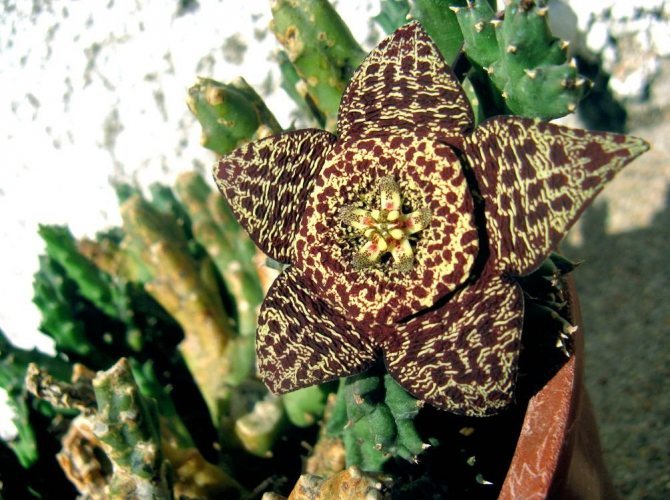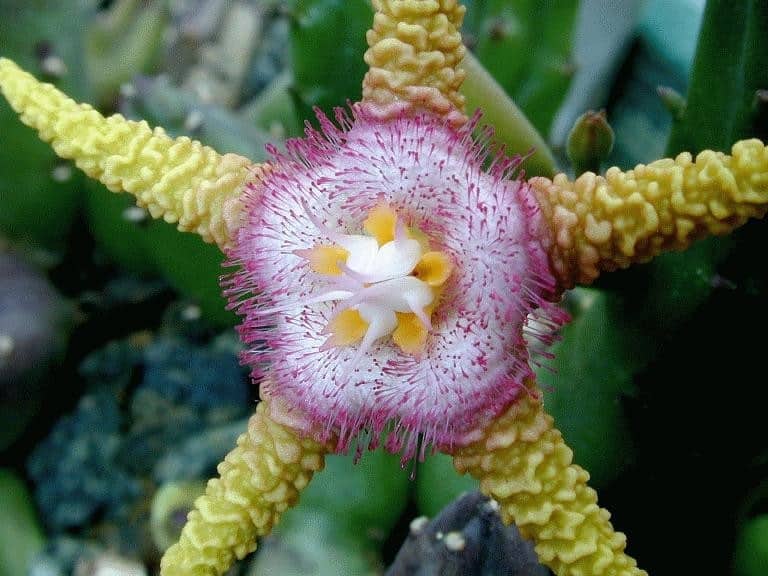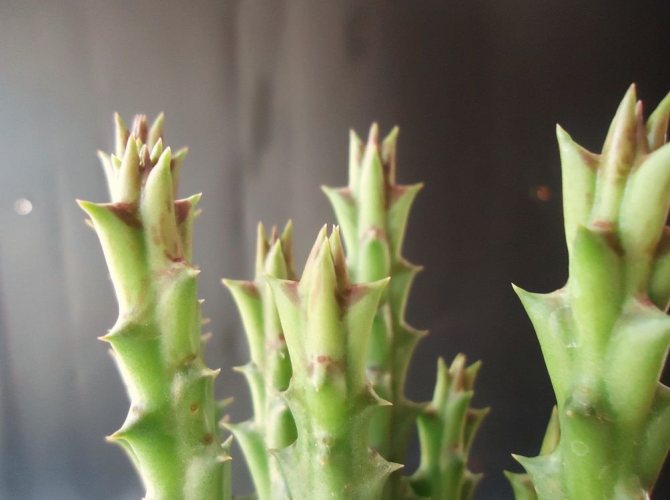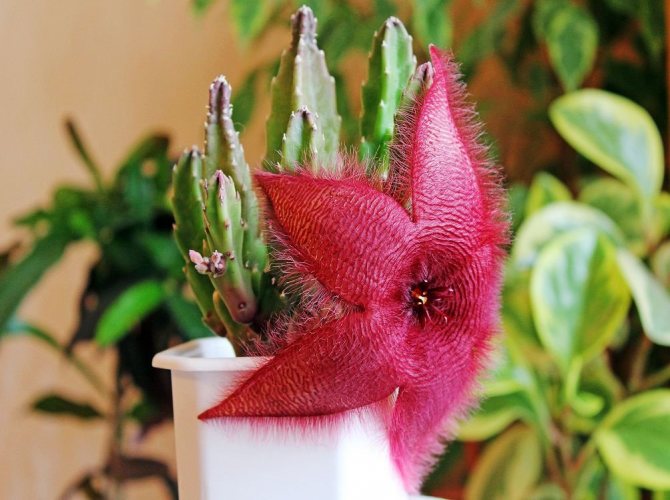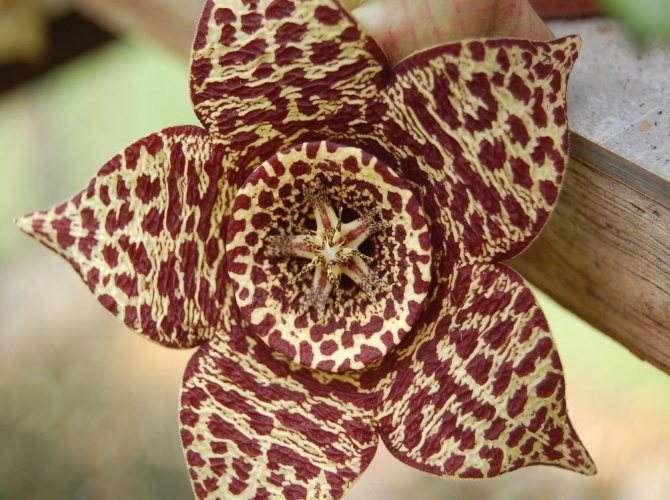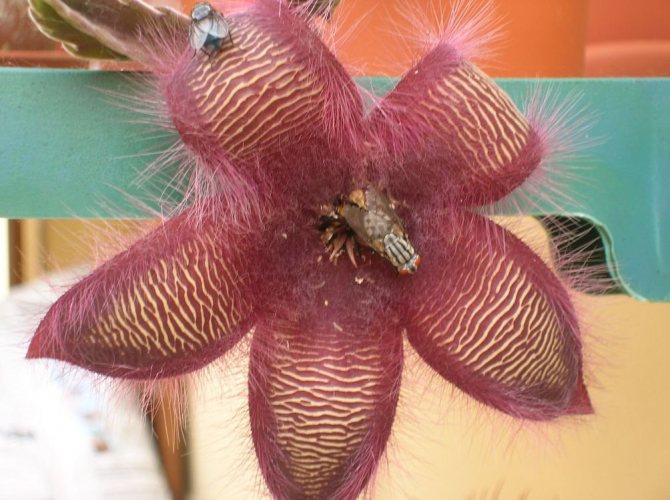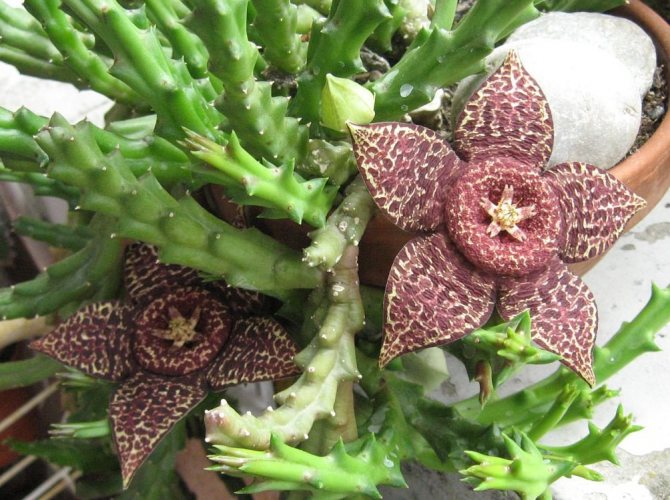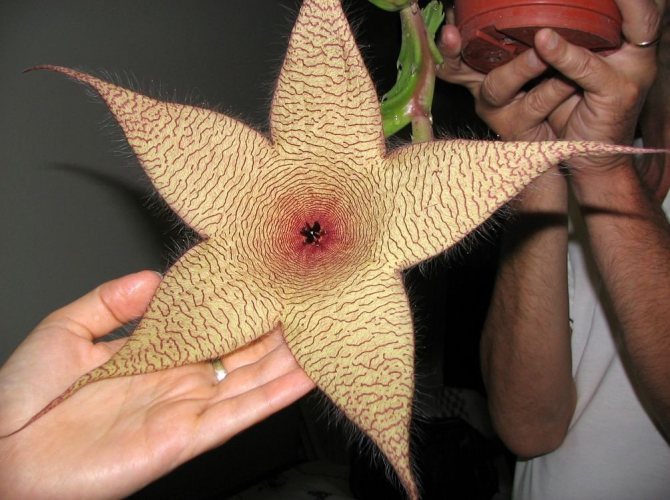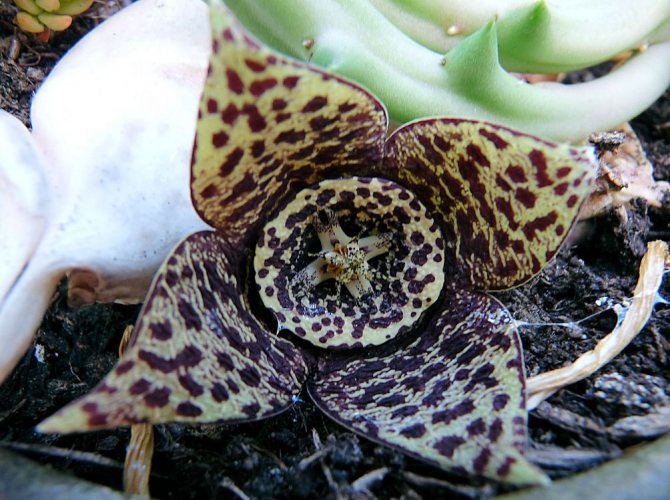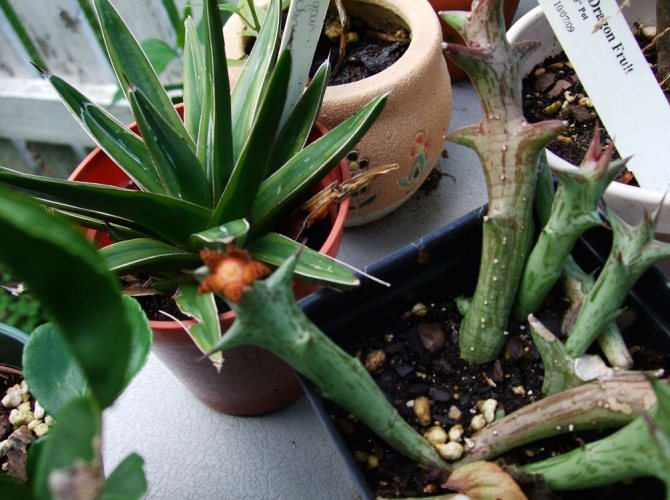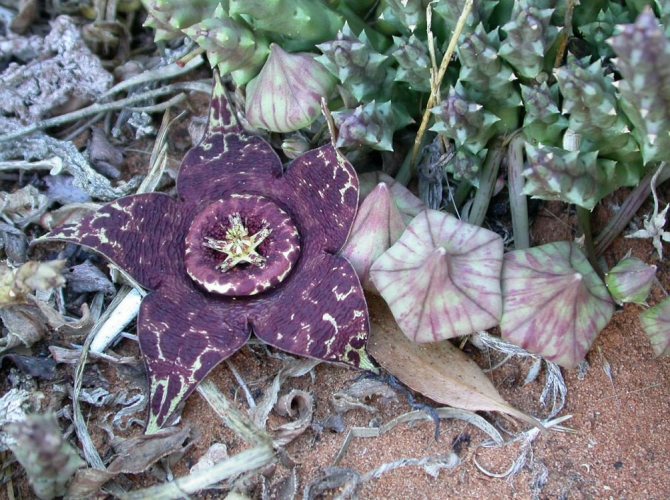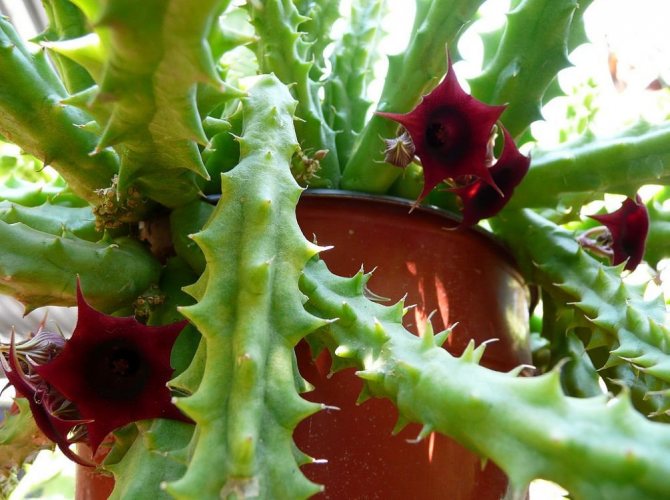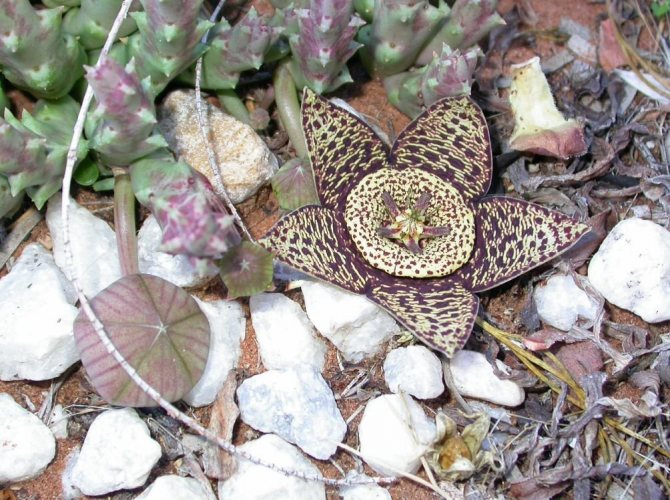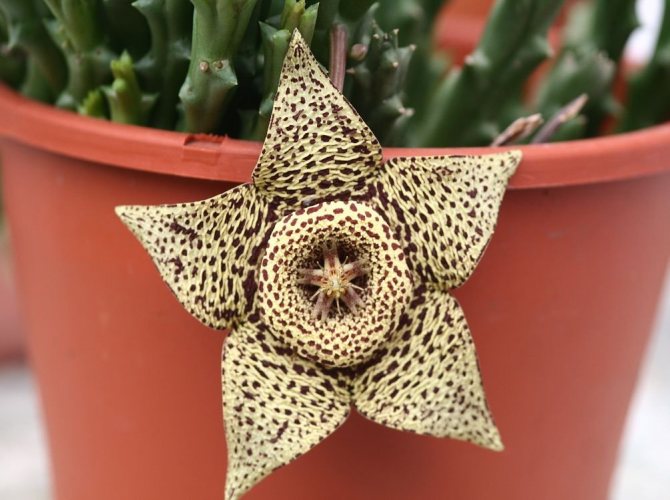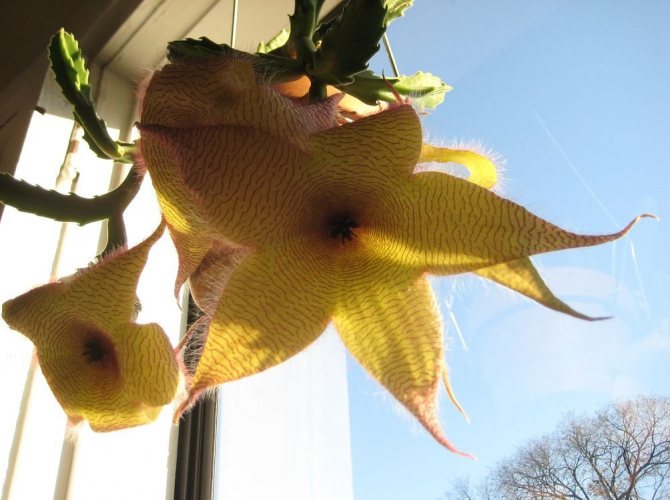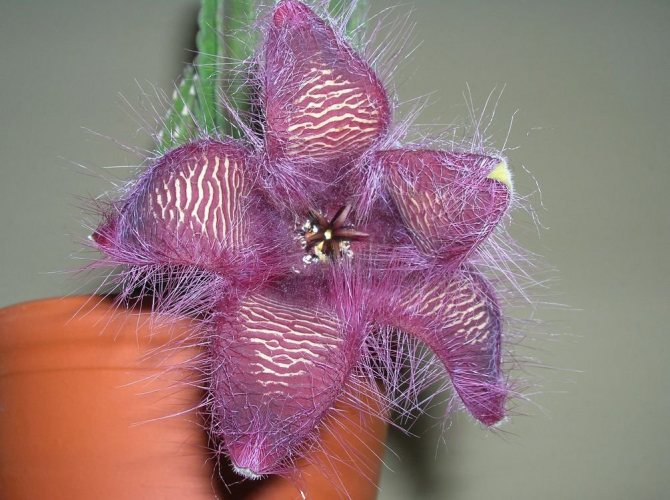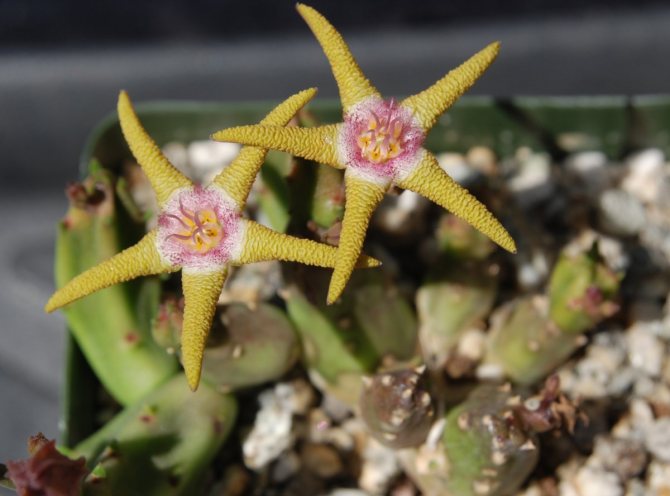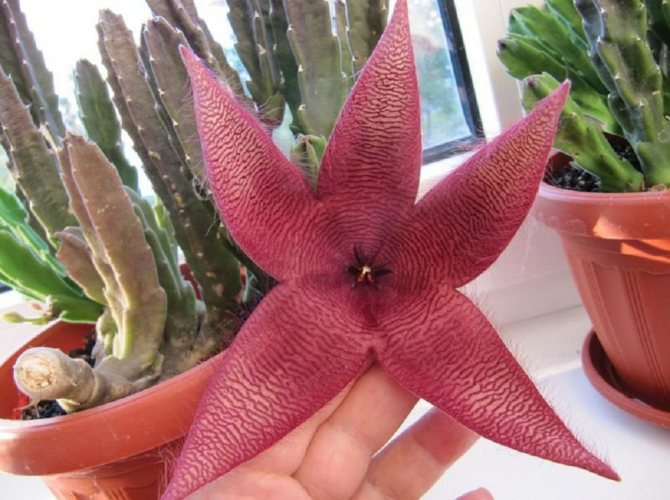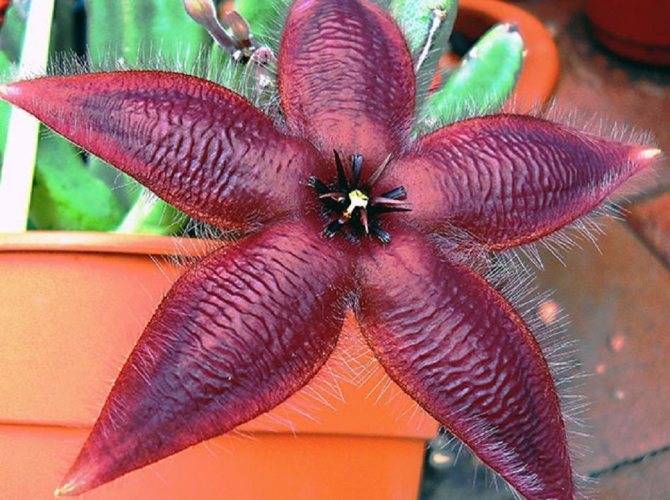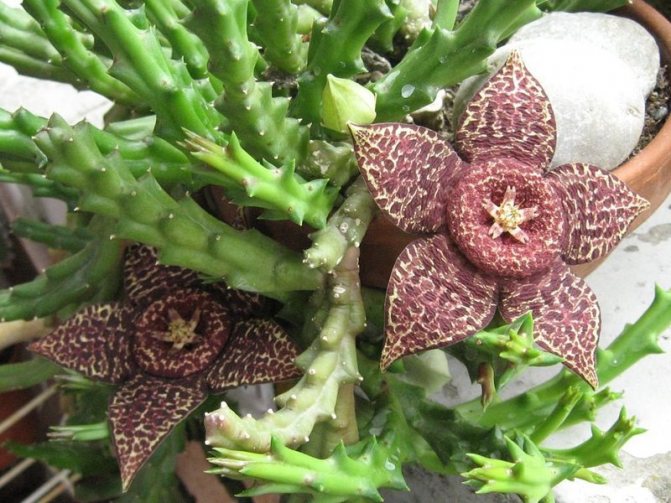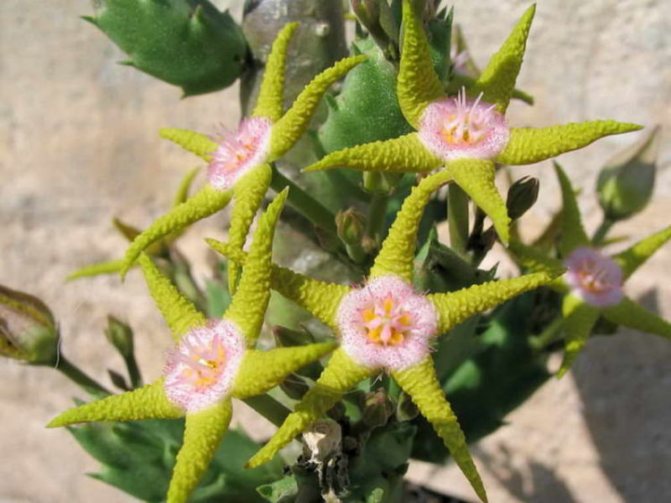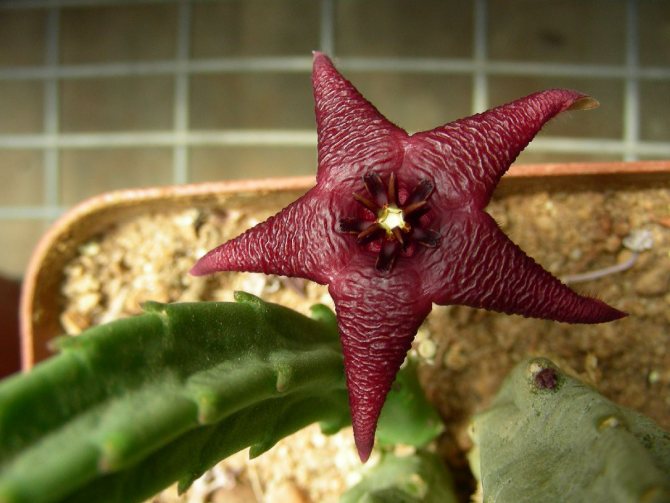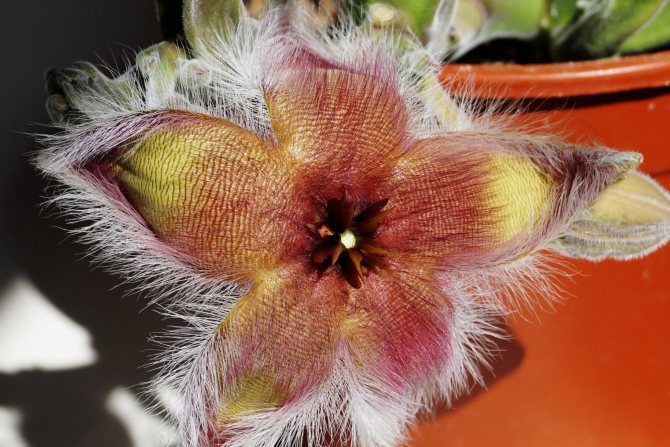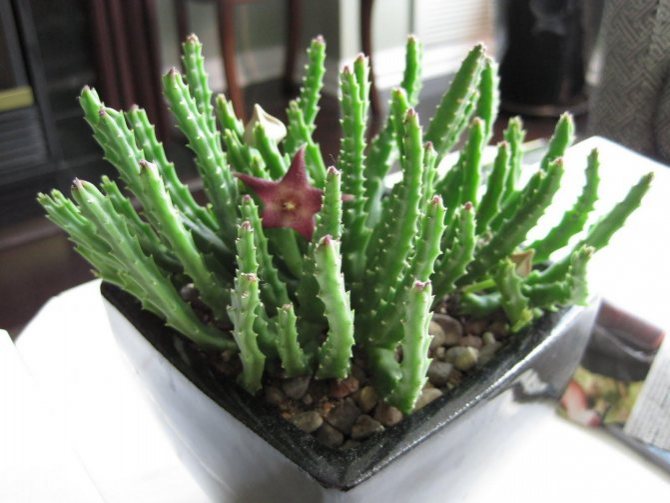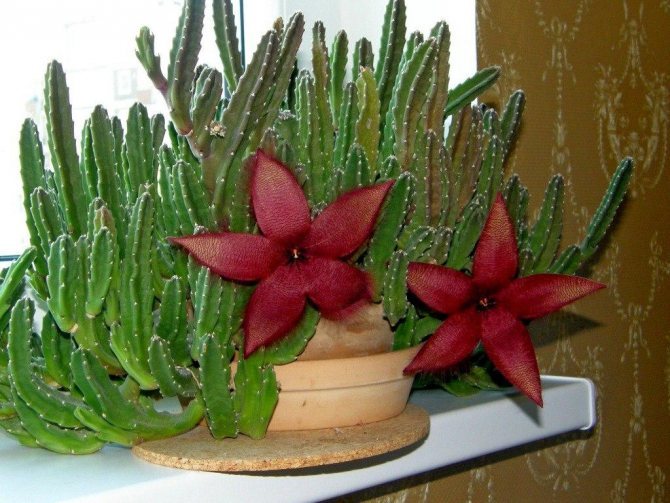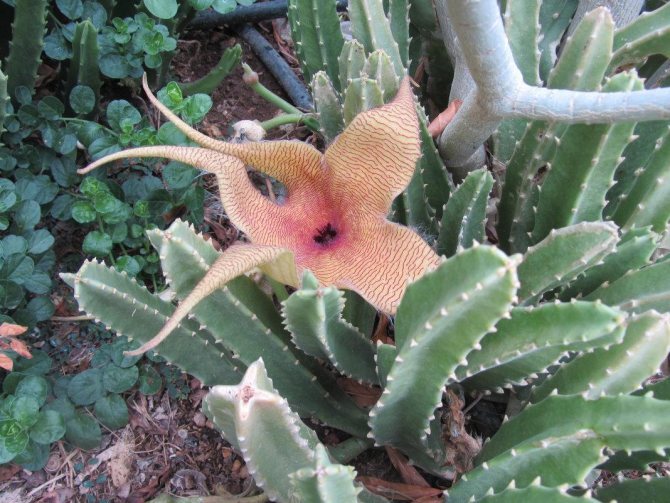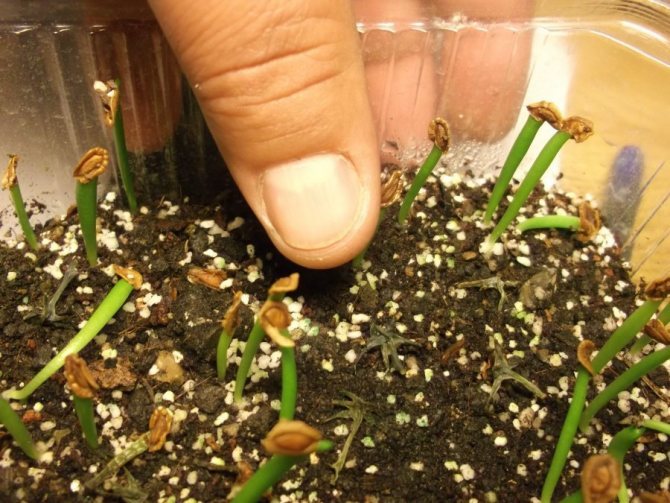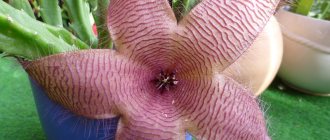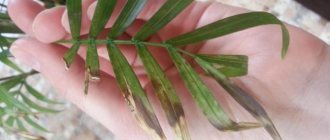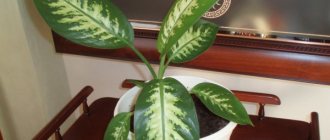Stapelia is a unique perennial succulent plant. This graceful flower was named after the Dutch biologist Johann Bode van Stapel. Many types of this plants are widespread in greenhouses and botanical gardens. They are often bred at home due to their unusual colors. Stapelia was introduced to Europe in the 17th century from South Africa. In natural conditions, there are more than 70 species of this plant. The flower is unpretentious and easy to care for, and even a novice florist can grow this beautiful plant.
Botanical description
Stapelia is a compact perennial plant. The height of adult specimens ranges from 10-60 cm. It has an underdeveloped, superficial root system. The terrestrial part consists of branched, ribbed processes with a smooth skin. Curved fleshy shoots are colored bright green with yellowish or pink spots and a whitish waxy coating. They have 4-6 facets of varying severity, along which relief protrusions are located, similar to short, hooked spines.
The flowering of the stocks, which occurs most often in the summer, is very interesting. First, large airy buds are formed the size of a chicken egg. They are located at the bottom of the shoot, although they can also be at the top. Each flower has its own long drooping peduncle. The buds bloom into bell-shaped or flat five-petal flowers. Their diameter is 5-30 cm. The bases of the fleshy petals grow together into a central funnel. Often there is a fleshy ridge in the middle. Along the entire surface of the petals, or only along the edge, there are long glandular villi of white or light pink color. The color of flowers can be variegated yellow-burgundy, lemon or red-orange.
The flowers are very unusual and beautiful, but at the same time they exude a very unpleasant, fetid odor. This is due to the fact that flies are the main pollinators. Only they are able to reach the pollen sacs. After pollination, the seeds ripen in fleshy seed pods for a very long time, the process can take up to a year or more.
Pests
To preserve your favorite flower, you need to know what pests damage the staples, home care consists in examining the stems and timely treatment with insecticides.
The flower can be attacked by such insects as aphids, mealybugs and spider mites, they create a real problem for flower growers. They all feed on the sap of the plant. The tree is especially vulnerable if you keep it on the balcony, because all kinds of winged creatures that harm the flower can get there from the street.
Stapelia cactus is easy to care for, even a novice florist can handle the cultivation. If properly cared for, a crop can bloom in its second year of life. It is worth getting this plant to delight yourself and your guests with flowers with an unusual description.
Popular types of stocks
According to the international classification, there are 56 species in the stocks genus. Many of them are very decorative due to the unusual shape of the flowers.
Large-flowered stapelia. This perennial succulent plant grows tetrahedral green shoots. They often branch out from the base. At the bottom of the stem in summer, a flower forms on a long, flexible peduncle.Its lanceolate petals are shaped like a starfish. Corolla diameter reaches 15-25 cm. Petals of purple or burgundy color are densely covered with long silvery fibers. Flowering lasts 2-5 days. During this period, the unpleasant aroma is practically absent.

Stapelia large-flowered
The stapelia is variegated. The plant has fleshy bright green stems that form an almost regular circle in cross section. Hooked teeth are located along the smoothed ribs. The height of the compact growth does not exceed 10 cm. In summer, bright variegated flowers with a diameter of 5-8 cm bloom. They are painted in yellow or cream color, against which contrasting brown or dark burgundy spots are visible. The flattened corolla in the center has a convex ring, which is framed by triangular petals. The unpleasant odor during flowering is quite strong. The plant easily adapts to adverse conditions.
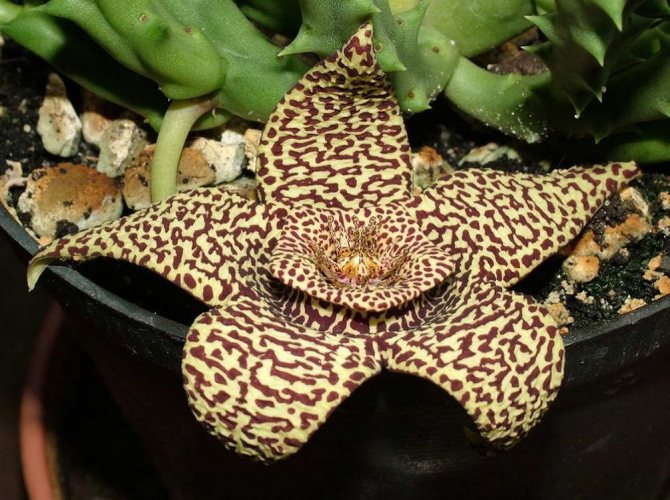

Stapelia variegated
The stapelia is star-shaped. The tetrahedral shoots of the plant do not exceed 20 cm in height. They are covered with a smooth greenish skin with pink or light purple stains. Tiny denticles are located along the borders. Flowers are grouped 1-3 at the base of the shoots. They have long, thin pedicels. The open stellate corolla is 5-8 cm in diameter. The petals are strongly dissected and twisted back along the longitudinal axis. The flowers have a glossy bumpy surface. The villi are clustered along the lateral margins. The color of the flower consists of red, orange and yellow shades.


Star-shaped stapelia
Stapelia are ferruginous. The height of this succulent does not exceed 15 cm. It has ribbed light green stems. During the flowering period, up to three flowers bloom at once. They are located at the base of the shoot on long drooping peduncles. The diameter of the lemon-yellow flower does not exceed 5 cm. Its surface is covered with many long pale pink or whitish villi. Semitransparent processes end with a thickening at the end.
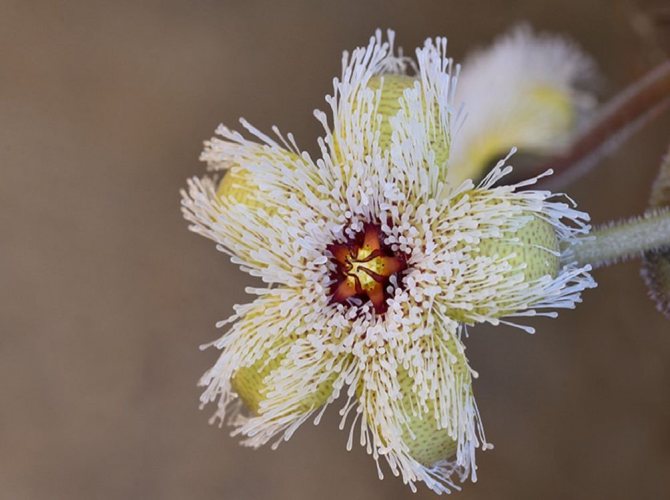

Stapelia ferruginous
The stapelia is gigantic. The plant has long, fleshy shoots with deep vertical grooves. During the flowering period, it dissolves the largest buds, the diameter of which reaches 35 cm. The hairy five-petal flower is painted in a creamy yellow shade with subtle burgundy strokes. The edges of the petals are strongly narrowed and elongated. Often the tips are twisted in a spiral. When flowering, the plant exudes an intense smell of rotting meat.
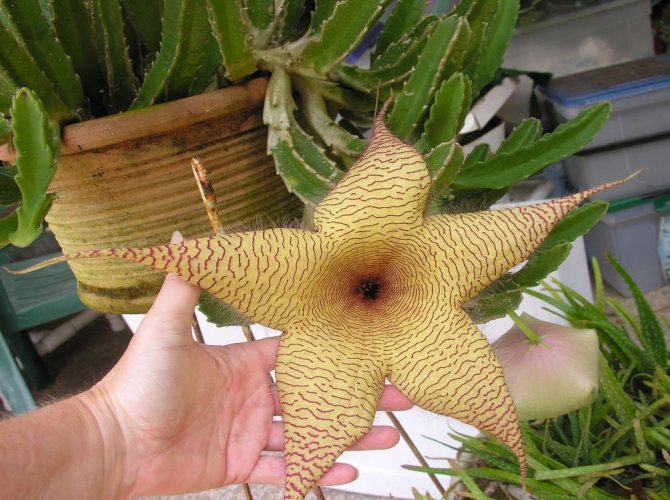

Giant stapelia
The stapelia are golden purple. The height of the fleshy ribbed shoots of a dark green color does not exceed 10 cm. Flowers bloom in the upper part of the stems and are collected in 1-3 buds. Corolla diameter is about 4 cm. It resembles a flat starfish with narrow, strongly dissected tentacles. The surface of the petals is covered with small tubercles and is colored light green or yellowish. The center contrasts with the tops. It is densely covered with pinkish pile and is painted in white and purple shades. The aroma of flowers of this variety is quite pleasant, albeit weak.
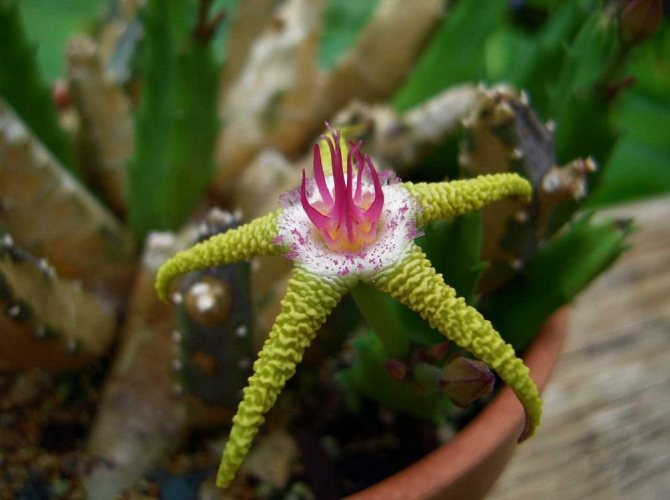

Stapelia golden purple
Types of a flower with a photo
Stapelia has about 100 plant species... Among the types of stocks, the types listed below are in special demand.
Star-shaped
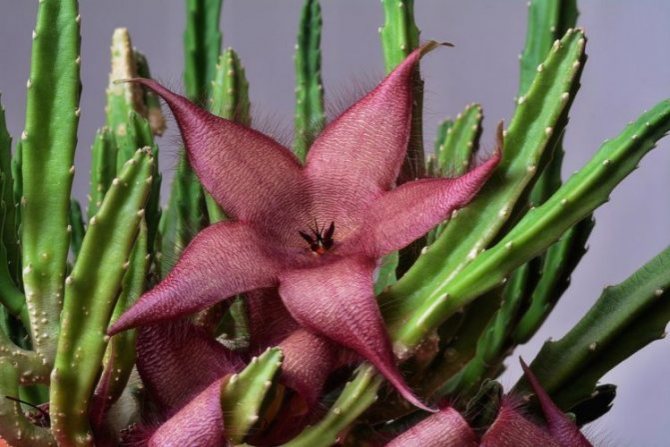

The plant is of short stature, 20 cm. It has green stems that can change their shade in the sun to red. The flowers are dark red with small yellow lines. They are located on long peduncles that arise from the base of the stems.
Giant


The bush grows to a mark of 20 cm. The plant got this name due to the huge flowers, the size of which is 35 cm. Their color is pale yellow, and they are covered with pink villi. This type of slipway does not have such a nasty smell as other representatives of the culture.
Variegated
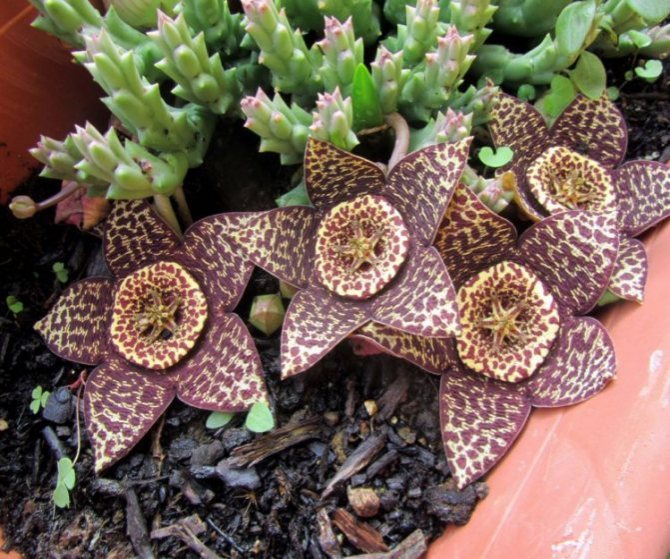

A variegated stapelia is a low bush that grows up to 10 cm... Its stems are green, slightly reddened. The flowers are yellow, have dark spots, and are covered with villi on one side.
Glandular
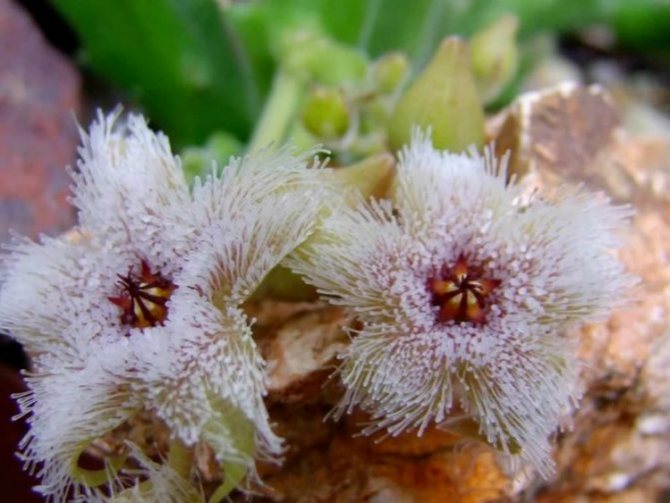

Its height reaches 15 cm. The plant forms a compact bush, consisting of green leafless shoots directed upwards. The flowers are green, covered with white hairs.
Golden purple
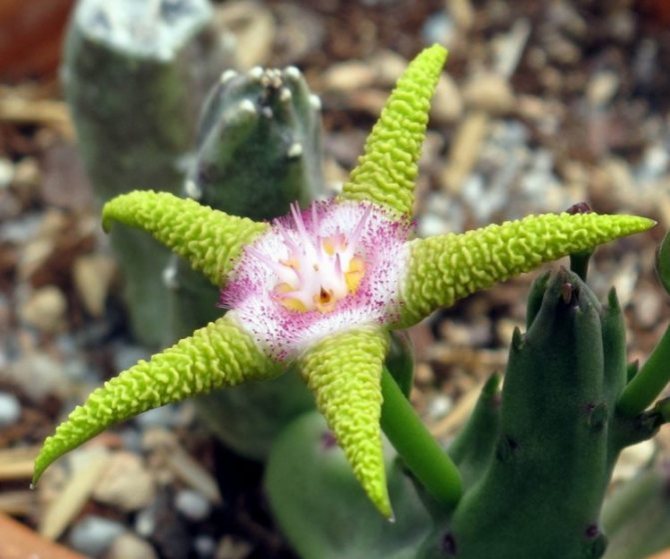

Golden-purple staples are presented as a low bush... The bush consists of green stems that turn purple in the sun.
The flowers of the golden-purple staple are quite unusual, as they have thin green petals, and inside there is a pink fluffy lump.
The scent of the flowers is reminiscent of wax, making it doubly pleasant to grow a plant.
Large-flowered


Compared to other species, this plant has shoots not with 2, but with 3 edges. Large-flowered staples are distinguished by lanceolate petals... The color of the flowers is pale yellow, and the surface is covered with a purple tint.
Volatile


Its stems reach a height of 15 cm. The color of the petals on the flowers is light green, and dark spots are scattered on their surface.
Reproduction methods
The stocks are propagated by seeds and cuttings. Freshly harvested, well-ripened seeds are sown directly into moist sandy-peat soil. They are spread on the surface, pressed in and lightly crushed with sand. The container is sprayed daily from a spray bottle. The first shoots can be observed after 22-28 days. Seedlings 1-1.5 cm high dive into disposable cups or small pots with soil for succulents. The next transplant is carried out in a year.
Stapelia is easily propagated by cuttings. To do this, in the spring, with a carefully cleaned blade, a lateral process 3-5 cm high is cut off. The cut site at the cuttings and the mother plant is crushed with charcoal. Before planting, the cutting is air-dried for 24 hours, and then rooted in sandy-peat soil. It is enough to press the cutting into the soil and create support for it. After the roots appear, the plant is transplanted into light fibrous soil from a mixture of turf, leafy soil, charcoal and river sand.
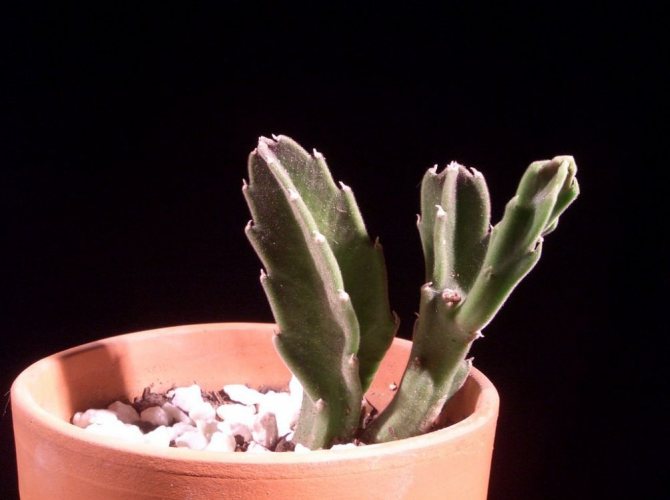

How to transplant a Stapelia?
Young flowers are transplanted in the spring once a year. Transplantation of adult flowers is carried out once every three years. When transplanting, those shoots are removed from the central part of the flower that are unlikely to bloom.
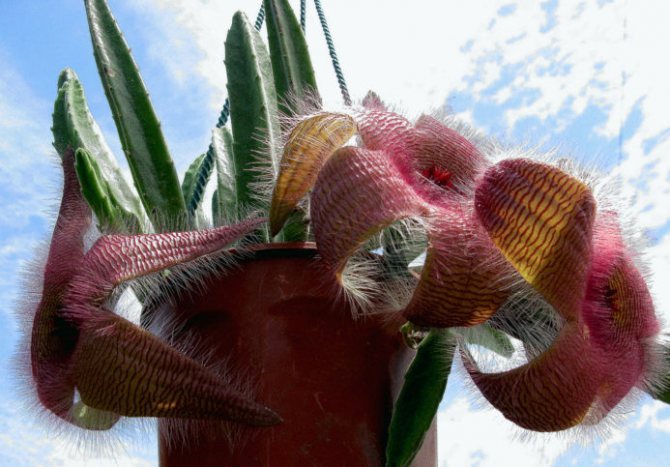

For transplant, you need to prepare:
- The pot is not deep, since the roots of the flower are poorly developed.
- Drainage is poured at the bottom of the pot... It takes up one third of the pot.
- The rest is covered with earth, which consists of sod land (2 parts), sand (1 part).
Important! The mixture can be replaced with cactus soil to which you need to add charcoal.
- Before replanting, the earth is steamed.
Planting and care at home
Stapelia is a rather fragile plant, so transplanting must be done very carefully. In order not to break the roots, they use the transshipment method while preserving an earthen ball. The best time for transplanting is spring. The procedure is carried out every 1-3 years. In this case, dry and old shoots can be removed, and a large bush can be divided into several parts.
The pot should be shallow but wide enough. A third of its height is filled with drainage material (expanded clay, pebbles, fragments of red brick). The free space between the roots and walls is filled with soil with a neutral or slightly acidic reaction. The soil should contain a large amount of river sand, as well as sod land and a handful of charcoal. Immediately after planting, the slipway must be placed in a place with diffused lighting. Refrain from watering for a week. When the flower adapts to the new soil, the soil is carefully moistened.
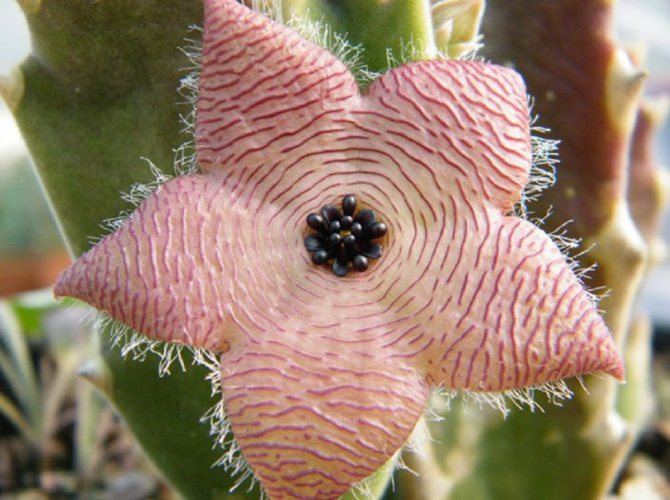

Caring for the slipway at home is not difficult.With the right location, unnecessary attention to the flower is not needed. If overprotected, often watered and rearranged from place to place, it can get sick.
Lighting. Stapelia needs bright, intense lighting. It can be placed on southern, western and eastern windowsills, but in summer it can be shaded from the midday sun. Excessive light and exposure to direct sunlight causes burns. They appear as dry brown spots on the leaves. Even reddening of the stems is the first signal of a problem. In winter, northern rooms may need additional lighting.
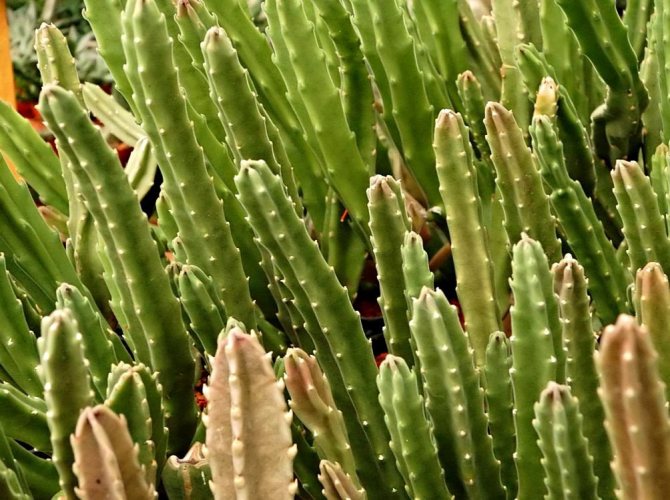

Temperature. In spring and summer, the optimum air temperature is + 22 ... + 26 ° C. You can take the flower out to the balcony, but carefully protect it from drafts. In November-February, it is necessary to provide the plant with a dormant period. At this time, it must be kept in a well-lit, cool room (+ 14… + 16 ° C). Cooling below + 12 ° C is not allowed.
Humidity. Like any succulent, the stapelia tolerates dry air well. It does not need additional spraying. Infrequent bathing under a warm shower is allowed, but during the flowering period you should refrain from them. When swimming, you need to protect the soil from the bay.
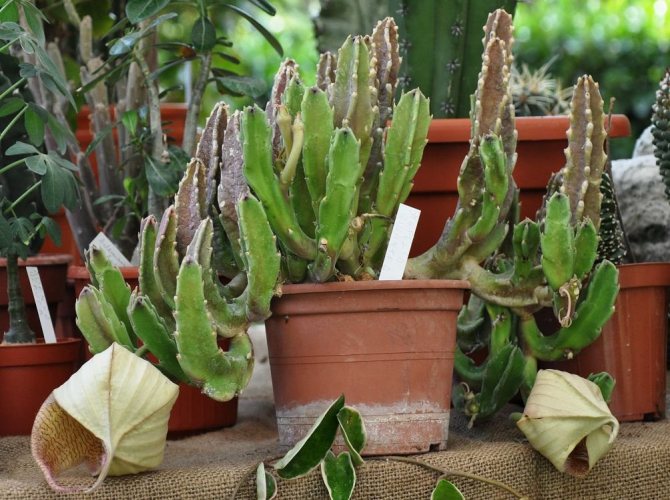

Watering. Stapelia needs moderate watering so that the soil dries out by half between irrigations. In the fall, as the temperature decreases, watering is done less often. In winter, it is enough to pour how many tablespoons into a pot to slightly moisten the soil.
Fertilizer. In April-September, stocks are fertilized with mineral compositions for cacti twice a month. The fertilizer solution is poured into the soil at a short distance from the roots. The complex should contain a sufficient amount of potassium, as it increases the plant's immunity. Since autumn, feeding is stopped completely.
Why doesn't it bloom and what to do?
The reasons why Stapelia does not bloom: fat of light, the plant overwintered in a warm place, excess or little moisture, feeding is carried out incorrectly. For flowering to occur, you must adhere to the following rules:
- in summer and spring watering when the ground is dry to the bottom of the pot, in October watered once a month, in December and January do not water;
- when the plant is at rest, the air temperature should be no higher than 15 degrees;
- plant need a lot of light;
- in soil there must be sand;
- can not be made excess fertilizer.
Possible difficulties
With proper care, the slipway does not suffer from plant diseases. If the soil is regularly poured, root rot may develop. In this case, it is almost impossible to save the mother plant. You need to have time to cut healthy cuttings and root them. Parasites almost never settle on stocks, so there is no need to worry about the safety of the flower.
When caring for a plant, you need to pay attention to its appearance. If the stems become pale and wrinkled, this indicates a bay. Elongated thin shoots indicate a lack of fertilizer and lighting. If the dormant period is improperly organized and there is a lack of lighting, flowering may not occur.
Care secrets
Location and lighting
The plant will like bright, diffused light. It is recommended to keep it on the sunny side, but without direct rays, they can burn the leaves, it is better to shade the plant with paper or tulle. Stapelia will tolerate direct rays well only in autumn and winter. Windows to the west or east are perfect for her.
Tip: plants that have been in the shade for a long time should not be immediately exposed to bright light, do it gradually.
Temperature regime and air humidity
Stapelia is a rather thermophilic plant, it prefers a moderate temperature without drops. Try not to put it on often ventilated places - the slipway does not tolerate drafts well.
Stapelia do not require high humidity and will grow in dry climates.
In winter, the room where the stapelia stands should be about 14-16 degrees, but not less than 12. In warm weather, she will like the temperature of 20-26 degrees.
If you have a loggia, then it is perfect for a slipway for the summer. In winter, do not place it near the balcony and next to the radiator.
Watering
The plant loves abundant watering, it is best to use warm, settled water.
From the beginning of spring to October, water is watered as the soil dries out; by autumn, watering is gradually reduced. In winter, the plant is in a dormant period, and it is rarely watered. But in the complete absence of watering, the stems wrinkle, part of the root system dies off, so do not forget about watering.
Cunning
The warmer it is in the room where the slipway stands in winter, the more often it needs to be watered!
Fertilizing and fertilizing plants
Fertilizing is advised during the period of greatest growth. For this purpose, organic and mineral fertilizers for succulents are suitable. It is advised to do this every 15 days. For the resistance of the slipway to disease, the soil must have a good potassium content.
Important: do not apply feeding in autumn and winter!
For more information on the rules for caring for a flower, see the video:
Flower transplant
Young plants are transplanted once a year in the spring from a pot not much larger in size than the previous one, adults - once every 2-3 years.
Tip: for good growth of new shoots, cut off old and dried stems, they will no longer appear flowers.
The soil is taken very sandy, for example, from 2 parts of turf and 1 sand, or they acquire a ready-made substrate for succulents by adding pieces of coal to it.


Transplanted young shoot with flower
The pots are not taken deep, the stock does not have a large root system. Be sure to drain expanded clay or shards, up to 1/3 of the height of the pot, this will not allow the water to stagnate, and the roots will rot.
Important: transplanted flowers do not disturb with watering for about a week.
Reproduction methods
The slipway is propagated in 2 ways:
- Seeds;
- Cuttings
Seeds
The seeds of the plant set well, but ripen slowly (within a year). They are planted in a light sandy substrate and within a month they germinate. Then they are dived and planted in pots 6-7 cm high in soil from 2 parts of leaf, 1 - turf, 1 - sand and 0.1 part of coal with lime.
Next year, they are transplanted into 7-8 cm pots by transferring them without damaging the root system.
Cuttings
Cuttings are taken from old shoots, dried and planted in the soil of sand and peat chips. Cuttings quickly acquire roots and waddle in 7-8 cm pots.


